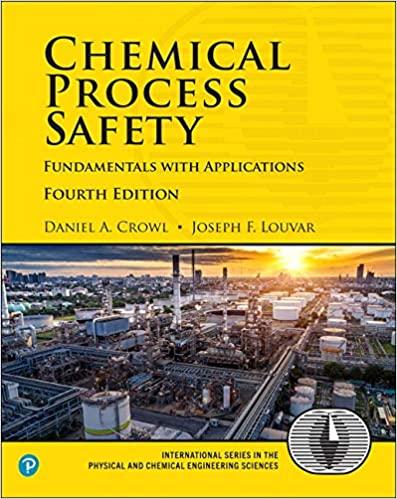A fixed mass of toxic gas has been released almost instantaneously from a process unit. You have
Question:
A fixed mass of toxic gas has been released almost instantaneously from a process unit. You have been asked to determine the percentage of fatalities expected \(2000 \mathrm{~m}\) downwind from the release. Prepare a spreadsheet to calculate the concentration profile around the center of the puff \(2000 \mathrm{~m}\) downwind from the release. Use the total release quantity as a parameter. Determine the percentage of fatalities at the \(2000 \mathrm{~m}\) downwind location as a result of the passing puff. Vary the total release quantity to result in a range of fatalities from 0 to \(100 \%\). Record the results at enough points to provide an accurate plot of the percentage of fatalities versus quantity released. The release occurs at night with calm and clear conditions.
Change the concentration exponent value to 2.00 instead of 2.75 in the probit equation, and rerun your spreadsheet for a total release amount of \(5 \mathrm{~kg}\). How sensitive are the results to this exponent?
Assume that the puff shape and concentration profile remain essentially fixed as the puff passes.
Supplemental information:
Molecular weight of gas: 30 Temperature: \(298 \mathrm{~K}\)
Pressure: \(1 \mathrm{~atm}\)
Release height: 0 Wind speed: \(2 \mathrm{~m} / \mathrm{s}\)
Use a probit equation for fatalities of the form
\[ Y=-17.1+1.69 \ln \left(C^{2.75} Tight) \]
where \(Y\) is the probit variable, \(C\) is the concentration in ppm, and \(T\) is the time interval in minutes.
Your submitted work must include a single output of the spreadsheet for a total release of \(5 \mathrm{~kg}\), including the puff concentration profile and the percent fatalities; a plot of the concentration profile for the \(5 \mathrm{~kg}\) case versus the distance in meters from the center of the puff; a plot of the percentage of fatalities versus total quantity released; a single output of the spreadsheet for a \(5 \mathrm{~kg}\) release with a probit exponent of 2.00 ; and a complete discussion of your method and your results.
Step by Step Answer:

Chemical Process Safety Fundamentals With Applications
ISBN: 9780134857770
4th Edition
Authors: Daniel A. Crowl, Joseph F. Louvar





